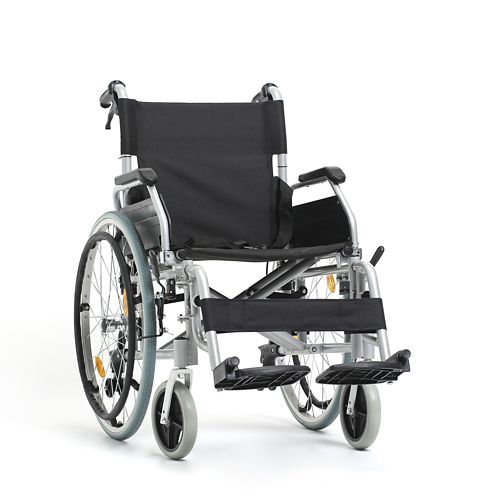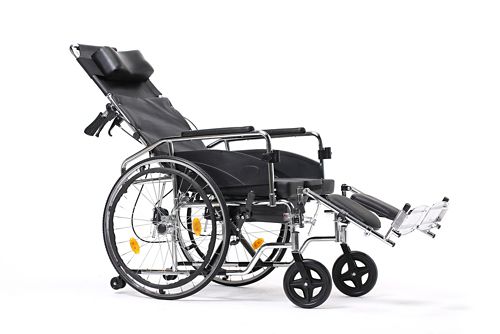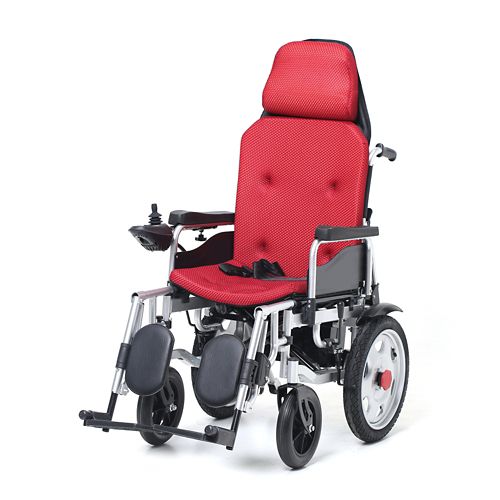How to use a manual wheelchair
Manual wheelchairs can be pushed by a caregiver or propelled by the user using the hand rims of the back wheels. Practice is needed to learn to self-propel a wheelchair. However, even younger children can become skilled at using a wheelchair.
The following tips provide basic information on using a wheelchair. However, your care team can provide specific information and training based on your wheelchair type and mobility needs.
Going forward in a wheelchair — To self-propel forward, grip the wheelchair hand rims near the back of chair. Push forward and down on the hand rims, and then let go. Move hands back to the starting position and repeat the motion.
Turning a wheelchair — To turn right, push forward on the left hand rim to propel the left wheel forward while slowing down or stopping the right wheel. To turn left, propel the right wheel forward while holding still or slowing down the left wheel.
Going backward in a wheelchair — To go backwards, grip the hand rims near the front of the chair. Push back and down to move the wheels backward. Anti-tips bars can be placed on the back of the wheelchair near the back wheels prevent backward tipping.
Stopping a wheelchair — To stop the wheelchair, grip the hand rims and use friction to slow them down. If the rims are wet, pinch the tire instead. Be careful, as this friction creates heat that can burn the hands, especially when on a slope or stopping suddenly.
Going up and down curbs or small steps in a wheelchair — The safest way to go up and down curbs is with caregiver assistance. If the user needs to negotiate a curb independently, more training and practice will be needed under supervision of a trained healthcare professional.
- To go up a curb, the caregiver should position the wheelchair directly facing (perpendicular to) the curb or small step, with the front wheels near the edge of the curb. The caregiver should use the handles to lean the wheelchair backward just enough for the front wheels to clear the curb or step and then. push forward so that the front wheels are placed on the curb. Continue pushing forward while lifting up on the handles until the rear wheels roll up the curb or small step. This may take added force to meet the resistance of the step.
- To go down a curb, it is best to go down backward. The caregiver should position the wheelchair perpendicular to the curb or small step with the rear wheels near curb. Slowly lower the rear wheels down the curb while leaning the wheelchair slightly backwards to allow the front wheels to clear the curb. Gently lower the front wheels to the ground.
Going up and down ramps in a wheelchair — Take care to maintain control when going up or down ramps or slopes. If going up a ramp independently, the user should lean slightly forward and use quick, short pushes to help momentum. When going downhill, maintain friction on the hand rims to control speed. A caregiver should always assist on steep slopes. Keep the wheelchair straight when going up or down slopes so that the chair does not tip over.
Locking the wheelchair — All wheelchairs have locks on each rear wheel. Locks allow for safety transferring to and from the wheelchair and during transportation. These locks may be referred to as “brakes”. However, the locks do not function the same as a brake and are meant for locking the wheelchair for safety and not for slowing the wheelchair. Custom wheelchairs, including adaptive stroller wheelchairs, may have locks placed on the back of the wheelchair that are more convenient for caregiver use.
Using public transportation in a wheelchair — Wheelchair anchors and lap belts can be added to wheelchairs if needed for public transportation purposes. Please discuss this with your therapist, Assistive Technology Professional (ATP), or Seating and Mobility Specialist (SMS).




